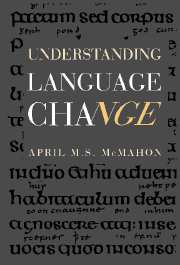Book contents
- Frontmatter
- Contents
- Preface and acknowledgements
- 1 Introduction
- 2 Three views of sound change
- 3 Sound change 2: the implementation problem
- 4 Morphological change
- 5 Syntactic change 1: the Transparency Principle
- 6 Word order change and grammaticalisation: language change and general laws
- 7 Semantic and lexical change
- 8 Language contact
- 9 Linguistic variation
- 10 Pidgins and Creoles
- 11 Language death
- 12 Linguistic evolution?
- Bibliography
- Index
2 - Three views of sound change
Published online by Cambridge University Press: 05 June 2012
- Frontmatter
- Contents
- Preface and acknowledgements
- 1 Introduction
- 2 Three views of sound change
- 3 Sound change 2: the implementation problem
- 4 Morphological change
- 5 Syntactic change 1: the Transparency Principle
- 6 Word order change and grammaticalisation: language change and general laws
- 7 Semantic and lexical change
- 8 Language contact
- 9 Linguistic variation
- 10 Pidgins and Creoles
- 11 Language death
- 12 Linguistic evolution?
- Bibliography
- Index
Summary
Introduction: types of sound change
In this chapter we shall investigate change in phonetics and phonology, primarily by outlining the approaches of three schools of linguists, in chronological order the Neogrammarians, Structuralists and early Generativists. This provides an opportunity to explore the development of sound change theory and introduce schools of linguistic thought which will be mentioned intermittently throughout the book. First, however, it may be useful to outline some of the types of sound change one might expect to encounter in any language.
Many sound changes affect single sounds, or vowel or consonant segments, and we shall concentrate on these below. However, some sound changes involve larger units, such as clusters of consonants, or diphthongs; and supra-segmentals such as rhythm, stress and intonation may also change. For instance, students of Germanic languages propose an early Germanic Accent Shift, which in general placed the main word stress on the first syllable of the stem; and English and German intonation patterns differ, although these languages are descended from a common source, so that we must assume changes in the intonational system of one or both daughters. It is certainly harder to study changes in suprasegmental features, since stress and intonation are rarely recorded in writing; but they do nonetheless occur.
Segmental sound changes can be conditioned, occurring in particular, specifiable environments, or unconditioned, applying to all occurrences of a particular sound. They may also be regular, or irregular and sporadic.
- Type
- Chapter
- Information
- Understanding Language Change , pp. 14 - 46Publisher: Cambridge University PressPrint publication year: 1994



